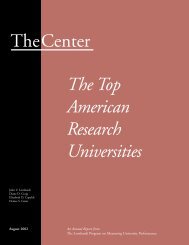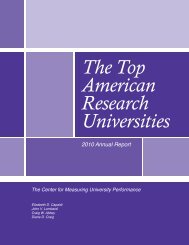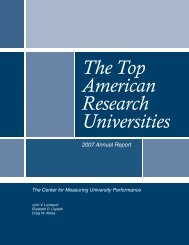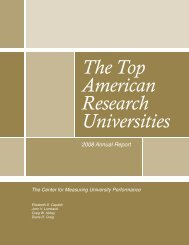TheCenter The Top American Research Universities
2005 - The Center for Measuring University Performance - Arizona ...
2005 - The Center for Measuring University Performance - Arizona ...
Create successful ePaper yourself
Turn your PDF publications into a flip-book with our unique Google optimized e-Paper software.
IntroductionBackground<strong>The</strong> task of building and sustaining an <strong>American</strong>research university challenges every member of theinstitution’s extended community. Progress in this permanentquest requires enthusiasm, commitment, talent,and resources as well as reliable comparative data.<strong>The</strong> task for universities is to improve – measured notonly by what they did last year or the year before butalso in comparison to what their counterparts andcompetitors have accomplished. Reference points forcomparative success serve the utilitarian purpose ofmeasuring progress.<strong>The</strong> <strong>Top</strong> <strong>American</strong> <strong>Research</strong> <strong>Universities</strong> annualreport charts the comparative performance of institutions,reflecting our conviction that research universitysuccess comes from effectively investing in andmanaging individual institutions. <strong>American</strong> universitiesexist in many different bureaucratic arrangements,and public universities in particular often form partsof complex statewide system structures. Nonetheless,the key decisions about faculty and students that producesuccessful research universities occur primarilyat the campus level. For that reason, this publicationfocuses on the performance of individual campuses,rather than systems, and adjusts the data to reflect theperformance of each campus within a system.<strong>The</strong> <strong>Top</strong> <strong>American</strong> <strong>Research</strong> <strong>Universities</strong> also presentsa categorization of research universities into groupsbased on their performance on nine measures, asdescribed in the introduction to the tables. Institutionsin the top group rank among the top 25 on allnine of the measures; in the second group they rank inthe top 25 on eight measures; and so on. We similarlycategorize universities that rank among the top 26 to50 on at least one of the nine measures. This methoddoes not produce a single ranked list; instead, itreflects our observation that the difference separatingthese top universities is not sufficiently great to justifycreating a single, rank-ordered list.<strong>The</strong> very best universities compete at top levels onmost everything they do. Others compete well onsome measures but not as well on others. <strong><strong>The</strong>Center</strong>definedgroups identify clusters of institutions withroughly comparable performance on a variety ofmeasures.This sixth edition continues the practice – begunwith the report’s second edition – of highlighting thenational competition among universities in <strong>The</strong> <strong>Top</strong><strong>American</strong> <strong>Research</strong> <strong>Universities</strong> tables, although we alsoinclude the tables for the <strong>Top</strong> Private and <strong>Top</strong> Publicinstitutions separately, as in the previous reports.This focus on national rankings recognizes that thecompetition for high-quality faculty and studentsis primarily a single endeavor in which both publicand private universities participate, regardless of theircontrol or ownership. A university’s private or publicownership (or control) influences some institutionalcharacteristics that bear on its competitiveness withinthe national context, rather than creating independentcompetitive contexts.In addition to the rankings tables, this editionof <strong>The</strong> <strong>Top</strong> <strong>American</strong> <strong>Research</strong> <strong>Universities</strong> continuesthe practice begun in the 2001 report of presentingdata for all major research universities, defined by<strong><strong>The</strong>Center</strong> as those having more than $20 million infederal research expenditures. <strong>The</strong>se tables include thenine indicators used to determine <strong>The</strong> <strong>Top</strong> <strong>American</strong><strong>Research</strong> <strong>Universities</strong>, as well as a variety of institutionaland trend data characteristics that may be ofinterest to many observers. <strong>The</strong> scope of these tablesnow includes non-federal research expenditures, totalresearch expenditures by major discipline, and moretrend data, and presents data on the top 200 institutionsfor each measure used in constructing thecategories.Each university, however, exists within a uniquecontext and has different interests in these data. Forthis reason, <strong><strong>The</strong>Center</strong> provides all of the data in thispublication as well as additional tables of related informationon its Web site [http://thecenter.ufl.edu] in twoformats. This publication, in its entirety, appears as aPDF file, available for downloading and printing. Allof the data tables presented in this report also appearon the Web site in Microsoft Excel format, suitablefor downloading and further analysis. In addition,the Web-based tables include data and institutionalcharacteristics for the approximately 600 universitiesand colleges with any federal research since 1990(versus the more-than-$20-million group presentedhere). <strong><strong>The</strong>Center</strong> Web site provides a variety of otherinformation, as well.<strong>The</strong> <strong>Top</strong> <strong>American</strong> <strong>Research</strong> <strong>Universities</strong> 2005Page








